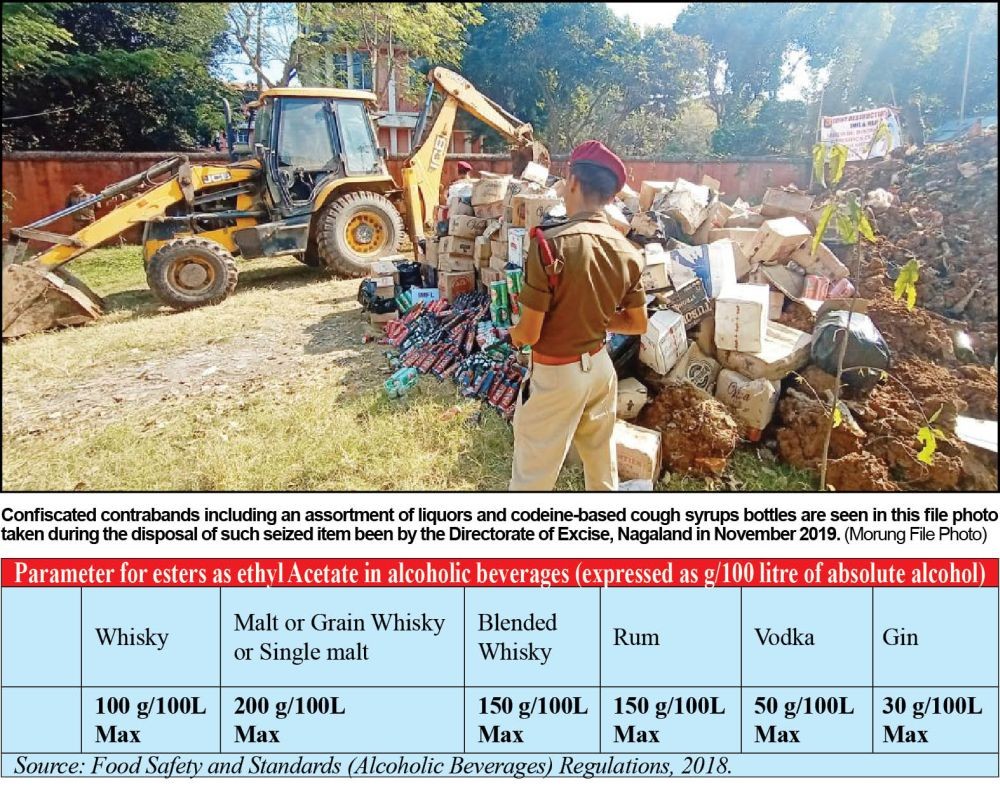
70% of sampled illicit liquor fails alcoholic spirits quality parameter
Imkong Walling
Dimapur | April 17
Prohibition should translate, ideally, into a liquor free environment. In such a world, liquor, let alone the spurious kind, should not exist. In Nagaland, both exist, only that the latter is as good a spectre— a shadowy but experiential form flowing through the guts of the law itself.
Branded illicit, liquor adulteration becomes a grey area by circumstance; an open secret beyond the purview of law enforcement, thus, enjoying unbridled freedom. It though is out there, existing as a known but unconfirmed phenomenon.
But now, a 2019 report has emerged attesting the phenomenon. In what could perhaps be the first officially sanctioned analysis of “alcoholic beverages” sold in the state, 70 percent of a batch of assorted liquor, put through laboratory analyses, failed to meet quality standard as specified by the Food Safety and Standards (Alcoholic Beverages) Regulations, 2018.
As per papers acquired by The Morung Express, the sample size composed of 30 different types of branded liquor, including but not limited to whisky and rum, collected from Dimapur and Kohima. The test samples were likely impounded illicit liquor as the batch from Kohima were indicated as sourced from the police. The samples from Dimapur were submitted by the district Food Safety Officer.
Most samples found adulterated
The test reports, submitted by the State Public Health Laboratory, Kohima, to the state government in April 2019, stated, “22 samples out of the 30 samples were found adulterated with esters as ethyl acetate.” The laboratory report added that the test samples analysed “does not conform to the prescribed standard of esters as ethyl acetate rendering” them “sub standard.”
The samples that failed the tests included McDowell’s No 1 series of rum and whisky, besides ABD’s Officer’s Choice and Officer’s Choice Blue, and Seagram’s Imperial Blue which are popular in Nagaland.
Higher-end brands were believed to have been free of defilement but one out of two Black Label (Johnnie Walker) samples failed the test, too.
In the vodka category, samples of Smirnoff, Magic Moments and Twist failed to meet standard, while a sample of McDowell’s Blue Riband Duet (gin) also failed.
Other samples from rum brands like Old Monk, Old Habour, Zino Dark and Zo XXX were also in the list of failed tests.
As per the Alcoholic Beverages Regulations, the maximum permissible limit for esters as ethyl acetate in various types of alcoholic spirits, range from 30 to 200 g/100 litre of absolute alcohol. (See table)
Meanwhile, the ethyl acetate content in ten whisky samples ranged from 112 g/100 litre to more than three times the prescribed maximum value. This value in seven rum samples ranged from 208 to as high as 448 g/100 litre.
It was over 3 to 7 times the prescribed limit in three vodka samples. The one gin sample breached the 30 g/100 litre maximum limit by almost 15 times.
Interestingly, seven samples of different beer brands and a sample of Breezer passed the test.
The total of samples from Dimapur was 11 (whisky- 8, vodka- 2 and rum- 1) with only one whisky sample passing the test.
Effects of ethyl acetate
The report did not contain research citations, however, it outlined the immediate effects and repeated or long term exposure to ethyl acetate would have on the body. Skin, eyes, nose and throat irritation; dizziness, lightheadedness and loss of consciousness were cited as some of the observable immediate effects.
The effects over the long term included drying and cracking of the skin; kidney and liver damage and acidosis.
Ethyl acetate is a naturally occurring organic compound found commonly in fruits and is also synthetically manufactured for use as a solvent, flavouring agent and is also used in perfumes and dyes. As described in encyclopedia.com, it is “a clear, colorless, volatile, flammable liquid with a pleasant fruity odor. Its appealing odor and fruity taste (in dilute solutions) explains one of its primary uses: as an additive in foods and drugs to improve their flavor.”
(This is the first of a three-part series)






